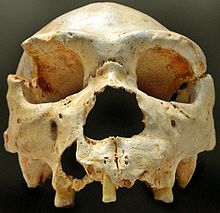- Miguelón
-
Miguelón Catalog number Skull 5 Common name Miguelón Species Homo heidelbergensis Age 400k Place discovered Atapuerca, Spain Date discovered 1992 Discovered by Bermúdez, Arsuaga & Carbonell  Cranium 5. The mandible (not shown) of this cranium was nearly intact.
Cranium 5. The mandible (not shown) of this cranium was nearly intact.
Miguelón (considered to be 400.000 years old) is the popular nickname for the most complete skull of an Homo heidelbergensis ever found. More than 5,500 human fossils of this species, which are considered to be the direct ancestor of Homo neanderthalensis, have been found in the Sima de los Huesos (The pit of bones) site in the Sierra de Atapuerca in northern Spain.
The excavators suggest that this concentration of bones in the pit may represent the practice of burial by the inhabitants of the cave. A competing theory cites the lack of small bones in the assemblage and suggests that the remains were washed into the pit by natural agents.
Miguelón, around thirty years old, had 13 impacts in the head and died of septicemia resulting from broken teeth. In his upper left jaw there is an important bone alteration, with evidence of alveolar infection. According to Arsuaga, a tooth had been broken in life by a strong coup, so that the flesh had been exposed and led to an infectious process that continued until nearly the orbital bone.[1][2]
The nickname Miguelón was derived from Miguel Indurain, a retired Spanish road racing cyclist that won the Tour and Giro in 1992, the year in which this skull was discovered.
See also
- List of human fossils
- List of hominina (hominid) fossils (with images)
References
- ^ "El cráneo «Miguelón» llega a Madrid". ABC. 2005-12-15. http://www.abc.es/hemeroteca/historico-15-12-2005/abc/Ultima/el-craneo-miguelon-llega-a-madrid_1013012469178.html.
- ^ "El cráneo de Miguelón". Tribuna Complutense. 2008-02-07. http://www.ucm.es/cont/descargas/prensa/tribuna562.pdf.
External links
- Human Fossils - The pit of bones (in Spanish)
Categories:- Anthropology
- Archaeological artefacts
- Hominin fossils
- Specific fossil specimens
Wikimedia Foundation. 2010.

